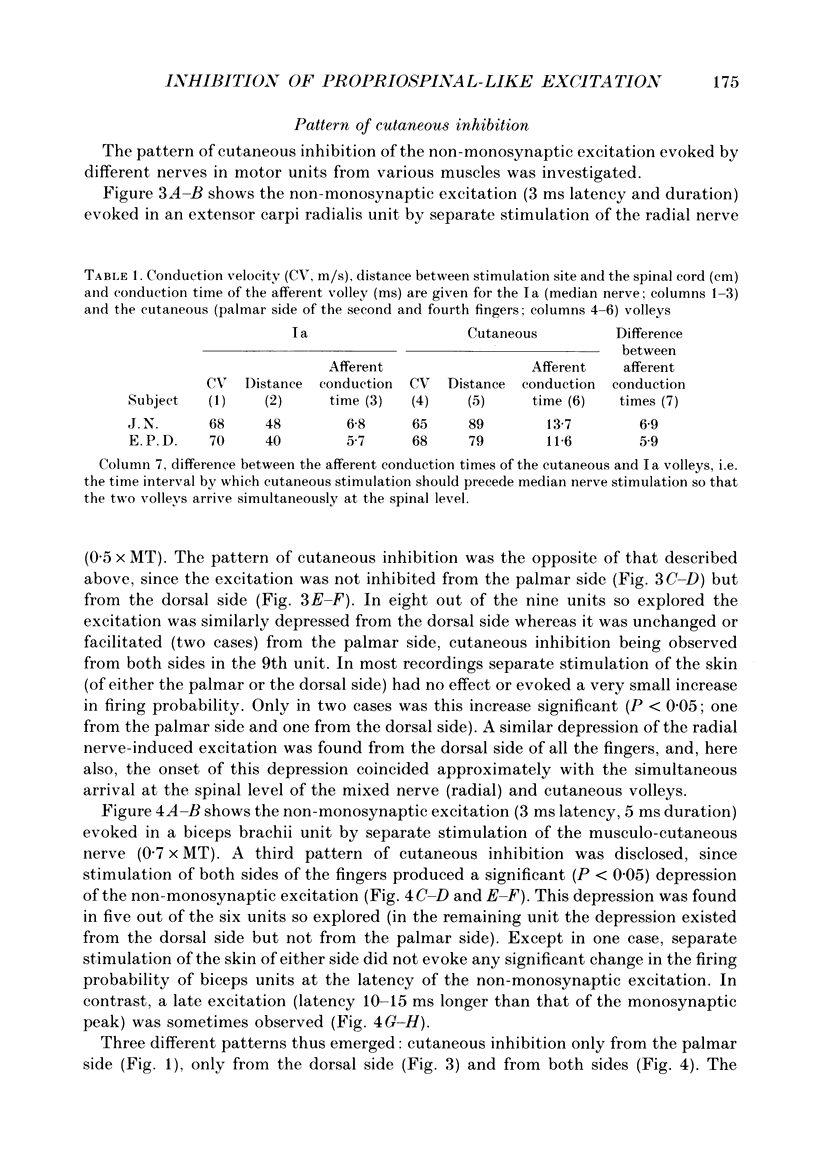Abstract
1. The pattern of cutaneous inhibition of non-monosynaptic excitation (or 'propriospinal-like' excitation) to various species of motoneurones-wrist flexors and extensors, biceps and deltoid - was investigated in man. 2. Changes in the firing probability of individual voluntarily activated motor units were studied following various stimuli. The effects of weak cutaneous stimuli applied to the skin of either the palmar or the dorsal side of the fingers on propriospinal-like excitation evoked by stimulation of different mixed nerves (median, radial, musculo-cutaneous) were investigated. 3. Cutaneous stimuli were found to produce an inhibition with a very specific pattern, which depended on the afferent input evoking the excitation. Thus, the median nerve-induced excitation of wrist and elbow flexors was depressed by cutaneous afferents from the palmar side but not from the dorsal side of the fingers; the radial nerve-induced excitation of wrist extensors was only depressed from the dorsal side: the musculo-cutaneous nerve-induced excitation of motor units of various wrist, elbow and shoulder muscles was depressed from both sides. 4. It is argued that this pattern implies that the excitation is mediated to the motoneurones through different subsets of neurones, organized according to the afferent input. 5. The functional significance of the pattern of cutaneous inhibition is discussed and it is argued that it could contribute to an appropriately timed termination of a movement mediated through the propriospinal system.
Full text
PDF













Selected References
These references are in PubMed. This may not be the complete list of references from this article.
- Alstermark B., Górska T., Johannisson T., Lundberg A. Hypermetria in forelimb target-reaching after interruption of the inhibitory pathway from forelimb afferents to C3-C4 propriospinal neurones. Neurosci Res. 1986 Jul;3(5):457–461. doi: 10.1016/0168-0102(86)90038-6. [DOI] [PubMed] [Google Scholar]
- Alstermark B., Kümmel H., Pinter M. J., Tantisira B. Branching and termination of C3-C4 propriospinal neurones in the cervical spinal cord of the cat. Neurosci Lett. 1987 Mar 9;74(3):291–296. doi: 10.1016/0304-3940(87)90312-0. [DOI] [PubMed] [Google Scholar]
- Alstermark B., Kümmel H. Transneuronal labelling of neurones projecting to forelimb motoneurones in cats performing different movements. Brain Res. 1986 Jun 25;376(2):387–391. doi: 10.1016/0006-8993(86)90205-2. [DOI] [PubMed] [Google Scholar]
- Alstermark B., Lundberg A., Norrsell U., Sybirska E. Integration in descending motor pathways controlling the forelimb in the cat. 9. Differential behavioural defects after spinal cord lesions interrupting defined pathways from higher centres to motoneurones. Exp Brain Res. 1981;42(3-4):299–318. doi: 10.1007/BF00237496. [DOI] [PubMed] [Google Scholar]
- Alstermark B., Lundberg A., Sasaki S. Integration in descending motor pathways controlling the forelimb in the cat. 12. Interneurones which may mediate descending feed-forward inhibition and feed-back inhibition from the forelimb to C3-C4 propriospinal neurones. Exp Brain Res. 1984;56(2):308–322. doi: 10.1007/BF00236286. [DOI] [PubMed] [Google Scholar]
- Baldissera F., Pierrot-Deseilligny E. Facilitation of transmission in the pathway of non-monosynaptic Ia excitation to wrist flexor motoneurones at the onset of voluntary movement in man. Exp Brain Res. 1989;74(2):437–439. doi: 10.1007/BF00248880. [DOI] [PubMed] [Google Scholar]
- Garnett R., Stephens J. A. The reflex responses of single motor units in human first dorsal interosseous muscle following cutaneous afferent stimulation. J Physiol. 1980 Jun;303:351–364. doi: 10.1113/jphysiol.1980.sp013290. [DOI] [PMC free article] [PubMed] [Google Scholar]
- Gracies J. M., Meunier S., Pierrot-Deseilligny E., Simonetta M. Pattern of propriospinal-like excitation to different species of human upper limb motoneurones. J Physiol. 1991 Mar;434:151–167. doi: 10.1113/jphysiol.1991.sp018463. [DOI] [PMC free article] [PubMed] [Google Scholar]
- Hulliger M., Nordh E., Thelin A. E., Vallbo A. B. The responses of afferent fibres from the glabrous skin of the hand during voluntary finger movements in man. J Physiol. 1979 Jun;291:233–249. doi: 10.1113/jphysiol.1979.sp012809. [DOI] [PMC free article] [PubMed] [Google Scholar]
- Hultborn H., Meunier S., Morin C., Pierrot-Deseilligny E. Assessing changes in presynaptic inhibition of I a fibres: a study in man and the cat. J Physiol. 1987 Aug;389:729–756. doi: 10.1113/jphysiol.1987.sp016680. [DOI] [PMC free article] [PubMed] [Google Scholar]
- Illert M., Lundberg A., Padel Y., Tanaka R. Integration in descending motor pathways controlling the forelimb in the cat. 5. Properties of and monosynaptic excitatory convergence on C3--C4 propriospinal neurones. Exp Brain Res. 1978 Sep 15;33(1):101–130. doi: 10.1007/BF00238798. [DOI] [PubMed] [Google Scholar]
- Malmgren K., Pierrot-Deseilligny E. Evidence for non-monosynaptic Ia excitation of human wrist flexor motoneurones, possibly via propriospinal neurones. J Physiol. 1988 Nov;405:747–764. doi: 10.1113/jphysiol.1988.sp017359. [DOI] [PMC free article] [PubMed] [Google Scholar]
- Malmgren K., Pierrot-Deseilligny E. Inhibition of neurones transmitting non-monosynaptic Ia excitation to human wrist flexor motoneurones. J Physiol. 1988 Nov;405:765–783. doi: 10.1113/jphysiol.1988.sp017360. [DOI] [PMC free article] [PubMed] [Google Scholar]


